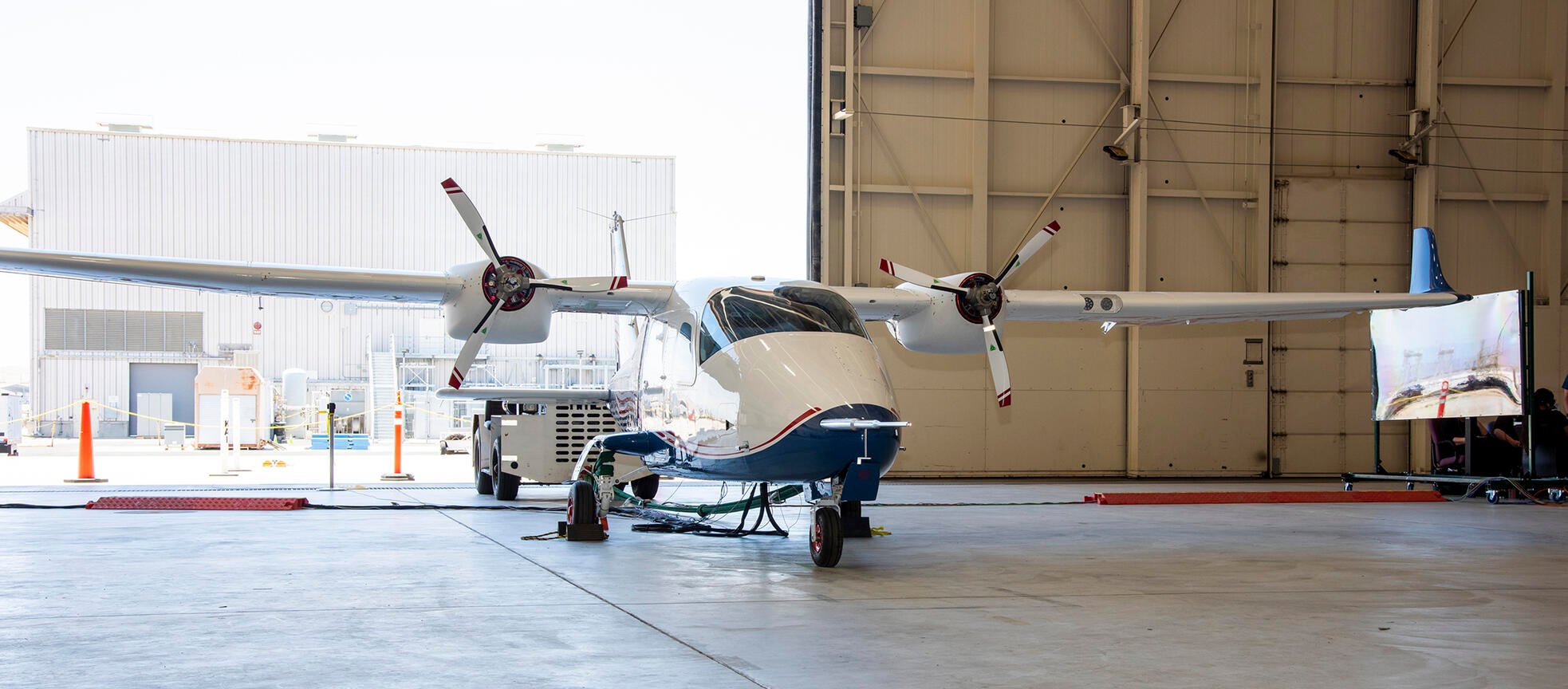Click Here to View This Page on Production Frontend
Click Here to Export Node Content
Click Here to View Printer-Friendly Version (Raw Backend)
Note: front-end display has links to styled print versions.
Content Node ID: 419891
NASA’s first all-electric experimental aircraft, the X-57 Maxwell, recently notched another milestone on the path to its first flight. Engineers at the agency's Glenn Research Center in Cleveland, Ohio, have successfully completed thermal testing of its cruise motor controllers.
The X-57 is a modified Tecnam P2006T twin-engine light aircraft that NASA is converting to run on electric power, with the intent of sharing its design and airworthiness process with regulators and the industry to help develop certification standards for emerging electric aircraft, including eVTOL vehicles for urban air mobility.
The cruise motor controllers are critical components of the X-57’s powertrain, as they convert the energy stored in the aircraft’s lithium-ion batteries to power the motors that spin the electric propellers. NASA conducted thermal tests on the motor controllers to validate their design and ensure that the temperature-sensitive components would be able to withstand extreme conditions during flight.
NASA says all the cruise motor controllers “survived” while operating inside the testing chamber at temperatures ranging from minus 11 degrees Fahrenheit to 147 degrees Fahrenheit (minus 24 degrees Celsius to 64 degrees Celsius), representing the temperatures that these aircraft components could experience in flight.
With the success of the thermal chamber testing, NASA is one step closer to flying the X-57 for the first time. But the version of the X-57 that will fly won’t look like the aircraft the agency has depicted in rendered images of the X-57. In fact, the final planned version of the X-57 likely won’t ever come to fruition, as the X-57 program is running out of time and funding. NASA plans to terminate it by the end of 2023.
When NASA introduced the X-57 in 2016, the plan was to build three different modifications of the electrically powered P2006T aircraft, with the first flying technology demonstrator—the Mod II—scheduled to make its inaugural flight in 2017. The program sought to demonstrate that airplanes could not only fly on electrical power but also that energy efficiency and performance could be significantly improved by replacing the two larger engines with an array of smaller engines distributed across the wing in what’s known as a “blown wing” configuration.
Unfortunately, the X-57 program got off to a rough start. During early tests of the aircraft’s lithium-ion battery packs in 2016, battery cells were short-circuiting and overheating, causing thermal runaway events. In 2017, NASA completely redesigned the battery packs to prevent potentially catastrophic fires.
Then came problems with the transistors. Although the state-of-the-art transistors used in the X-57’s electrical systems were built to withstand the high levels of power required to fly an electric aircraft, it turned out that they could not handle extreme temperatures and vibrations experienced during flight when they underwent ground testing. The program faced several delays due to these technical glitches, and disruptions caused by the Covid-19 pandemic in recent years set the timeline behind even further.
When the X-57 takes flight for the first time, it will be an iteration NASA calls Mod II, which has two electric propellers replacing the P2006T’s two Rotax combustion engines. The agency has been developing the Mod II concurrently with the Mod III, which would use the same powertrain as the Mod II but with a structural redesign featuring a smaller, high-efficiency wing. For the Mod III, the P2006T’s original motors are replaced by two electric motors produced by eVTOL developer Joby Aviation, one of NASA's commercial partners for the project. The motors and propellers would also be relocated closer to the wingtips.
The final iteration, known as the Mod IV, would have 14 electric propellers—two large propellers at the tip of each wing with 12 smaller propellers mounted along the front edge of the wing. This configuration increases the airflow under the wing to produce lift even when the airplane is flying slowly, allowing it to utilize shorter runways. The goal was to provide a 500 percent increase in high-speed efficiency, compared with the standard Tecnam aircraft, without the carbon emissions.
However, time and funding are running out for the X-57 program, and NASA has yet to fly any prototype of the X-57. So far, the only flight tests the program has conducted were with an unmodified P2006T, and those flights were intended to collect data for future comparison with information collected during flight tests of electrified versions of the X-57.
Although NASA did not succeed at producing all three planned iterations of the X-57, the agency still managed to do what it set out to achieve with the program: to help develop standards for future electric aircraft. NASA has been working with standards organizations ASTM International and RTCA to inform and align the development of standards for new commercial aircraft with architectures similar to that of the X-57 Maxwell, such as Eviation’s Alice, which made its debut flight in September 2022.
NASA may stop working on its own electric aircraft this year, but the agency will remain engaged with the advanced air mobility industry to help inform the design and operations of next-generation electric aircraft. NASA is also working with industry partners such as MagniX and GE Aviation to demonstrate new electric propulsion technologies through an initiative called the Electrified Powertrain Flight Demonstration (EPFD). The agency aims to introduce these electric propulsion technologies to U.S. aviation fleets by 2035, supporting short-range and regional air travel and single-aisle airliners.
